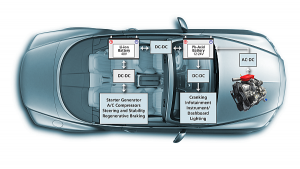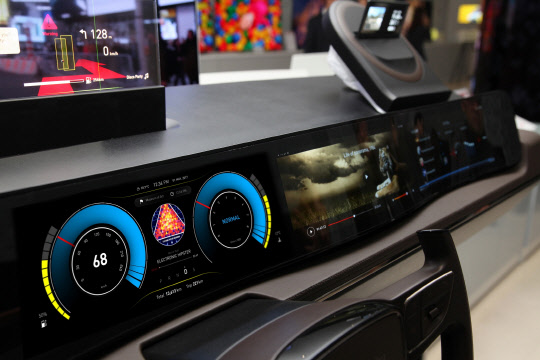By, Travis William, Senior Manager; Product Management and Marketing, Vicor Corporation
Have you driven a new automobile recently? It can be an almost futuristic experience, with sophisticated gauges, touch screens, connected entertainment systems, and lighting—all of which need power. Behind all these electronics are battery regulators and battery chargers that manage the power both into and out of 12V, 24V, and 48V batteries. Each year the ‘must have’ list of supported accessories and electronic systems grow with the expectation that the size, weight, and a number of supporting power components will keep pace with the increased power demands.
The emergence of 48V in automotive power
Automobile electronics consume a lot of power, and in an effort to keep up with these demands, many newer vehicles are equipped with dual battery systems comprised of traditional lead-acid 12V batteries and 48V Lithium Ion batteries. Already popular in Europe, “micro” and “mild” hybrids are gaining momentum worldwide, including the U.S. market. Micro and mild hybrid vehicles use 12V batteries and 48V Li-ion batteries. These dual battery vehicles shutdowns the engines when the vehicle comes to a stop, and restart it when the driver depresses the clutch or steps on the gas pedal. This automatic stop/start feature has been shown to improve fuel economy between 5-10%.
In these systems, the 12V or 24V lead acid battery supports cranking and all the typical electronics in traditional automobiles, like the dashboard, entertainment systems, and headlights etc. The 48V Li-ion battery supplies power to the high load systems like AC compressors and active chassis systems, which may include steering, regenerative braking and stability management. As seen in Figure 1, dual battery approaches rely on different battery technologies operating at different voltages to complement each other. This result in the need for line regulators that can accept wide input voltages and can switch between buck (step down) and boost (step up) modes while providing a stable regulated output.

Some would argue that the dual battery mixed voltage system is only a stepping stone to full 48V automotive systems. In the next 5-10 years, 48V electronics will begin displacing the traditional 12V rail for automotive electronics. During this transition, there will be an increased need for power components that can support legacy 12V systems and 48V systems of the future.

